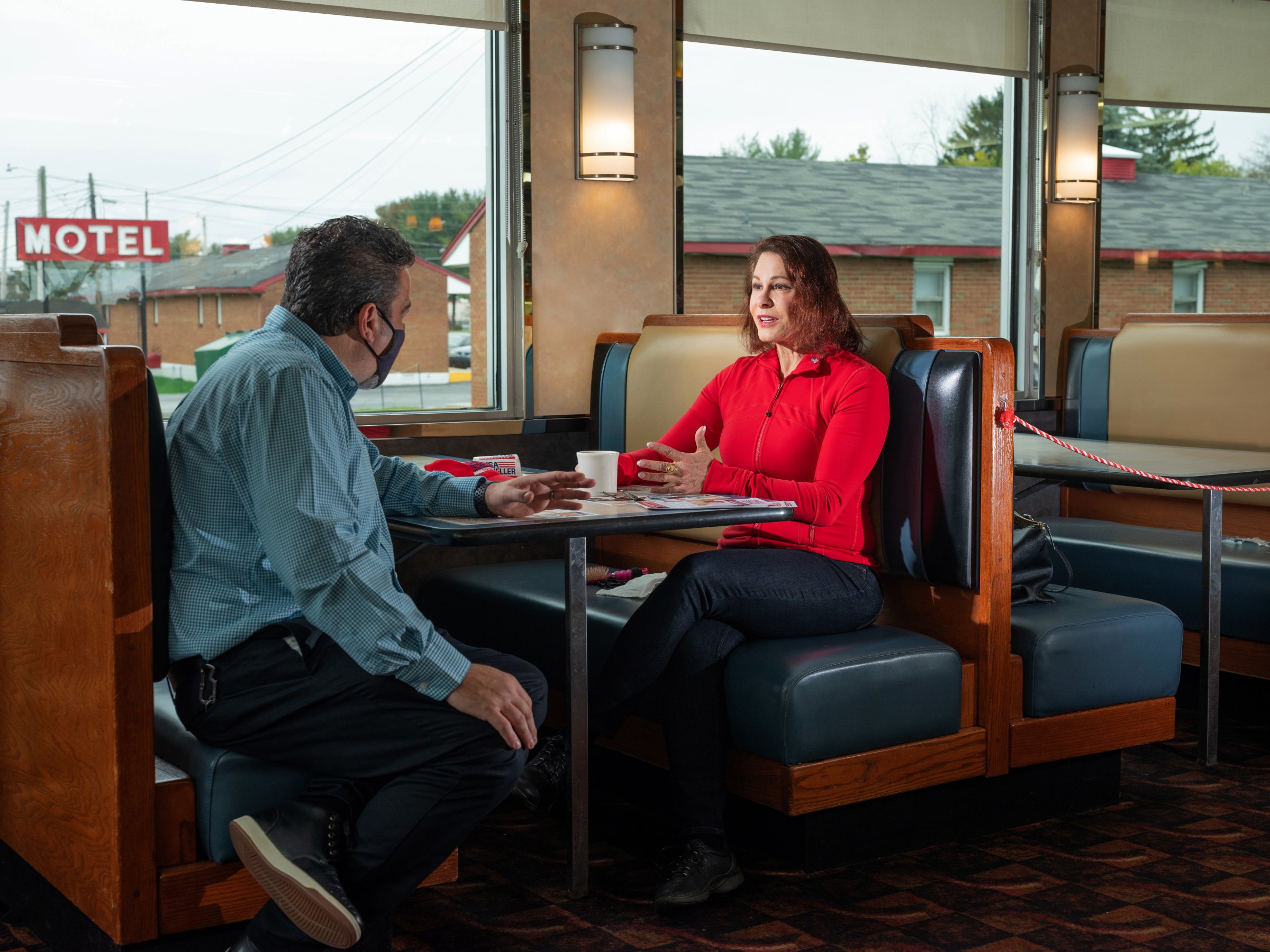
If the Republican Party could design its ideal female Congressional candidate for a moderate district in a swing state, she would probably look like Lisa Scheller.
The 61-year-old chemical manufacturing executive is a lifetime member of the National Rifle Association and the mother of two grown children. Staunchly conservative and relatable, Scheller is able to navigate a rhetorical tightrope, touting her political independence from national Republicans, even as she appears at a Trump campaign event. And she offers a compelling personal narrative: as a young adult, she struggled with heroin addiction, spent time in a halfway house, and emerged from the experience committed to helping her hometown overcome the opioid crisis. In 2018, Scheller launched “Hope & Coffee,” a cafe that employs recovering addicts and serves as a gathering place for support groups.
Her persona and message has appeal among both suburbanites and rural voters who make up Pennsylvania’s newly-drawn 7th District, in the bucolic Lehigh Valley. In 2016, voters in the area swung for Hillary Clinton, but just barely—by a point—making it a natural pick-up opportunity for a Republican in her mold. And unlike many other GOP House candidates this year, Scheller is insulated from some of the most acute financial pressures: she poured more than $2 million of her own fortune into her campaign.
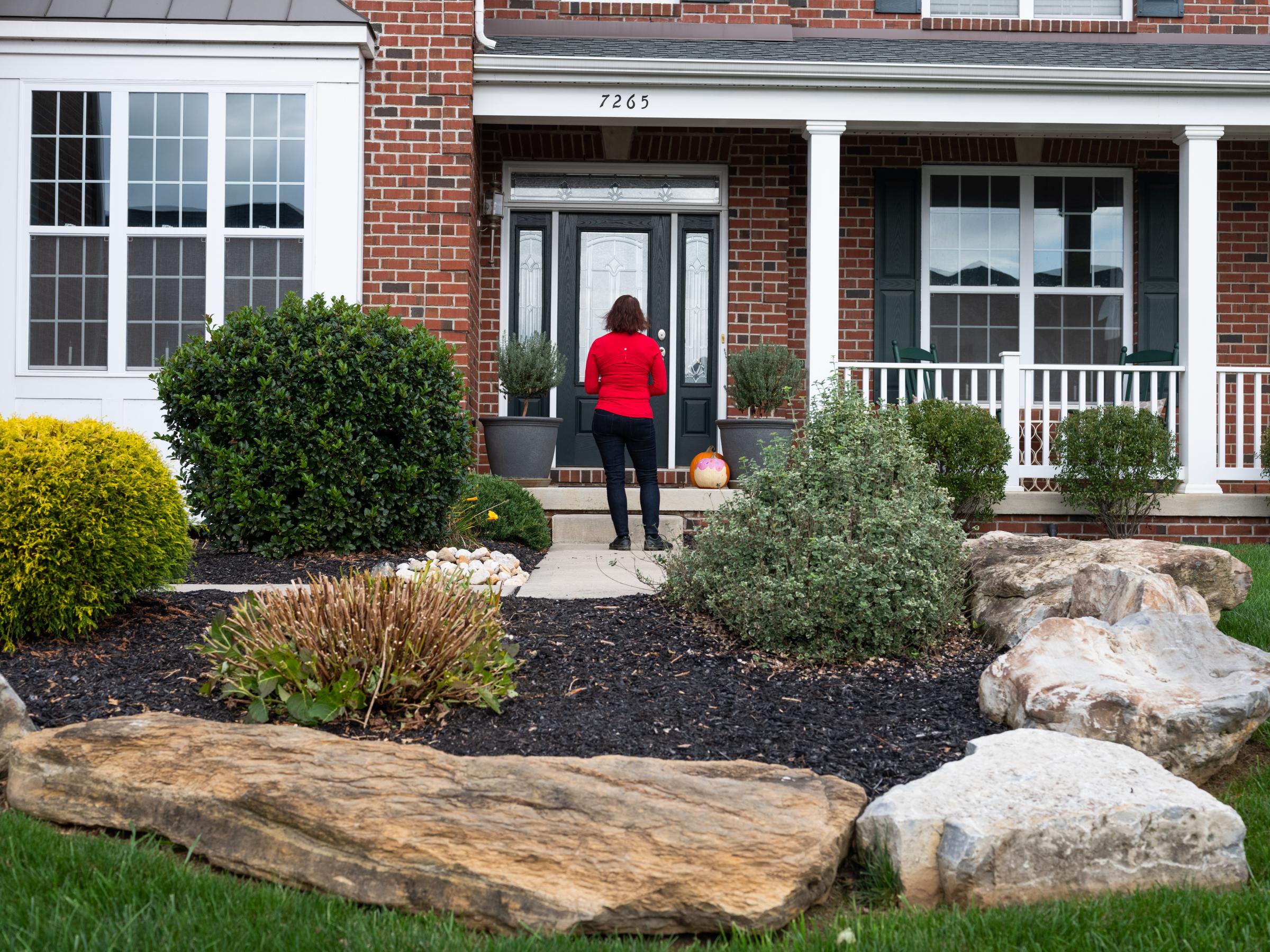
“She has such an interesting bio and background, and she has the resources to make this race competitive,” said Parker Poling, the executive director of the National Republican Congressional Committee (NRCC). “I don’t think there’s any candidate in the country that has a story like hers.”
But by fall, she was trailing Democratic incumbent Democrat Susan Wild by 13 points, nearly double the margin that Donald Trump is trailing Joe Biden in the Keystone State, according to polls. That gap, says Christopher Borick, a political science professor at Muhlenberg college, is hardly an indictment of Scheller or her campaign. If anything, he says, it’s bad timing. “There’s certainly no wind at the back of Republicans in Pennsylvania,” Borick says. “The President might have his own particular magic, but it doesn’t really translate to other Republicans” this year.
Scheller’s promising rise—and, now, her likely fall—offers an instructive, if painful, lesson to top Republicans, including Rep. Elise Stefanik, who pulled out all the stops this year in an effort to usher in a wave of female Republican lawmakers. The year started out well: a record-breaking 227 Republican women filed to run for the House of Representatives this cycle, smashing the previous record of 133 in 2010, according to data from the Center for American Women and Politics. Nearly 100 of these women won their primaries and became their party’s nominee, nearly doubling the previous record of female Republican candidates in a general election.
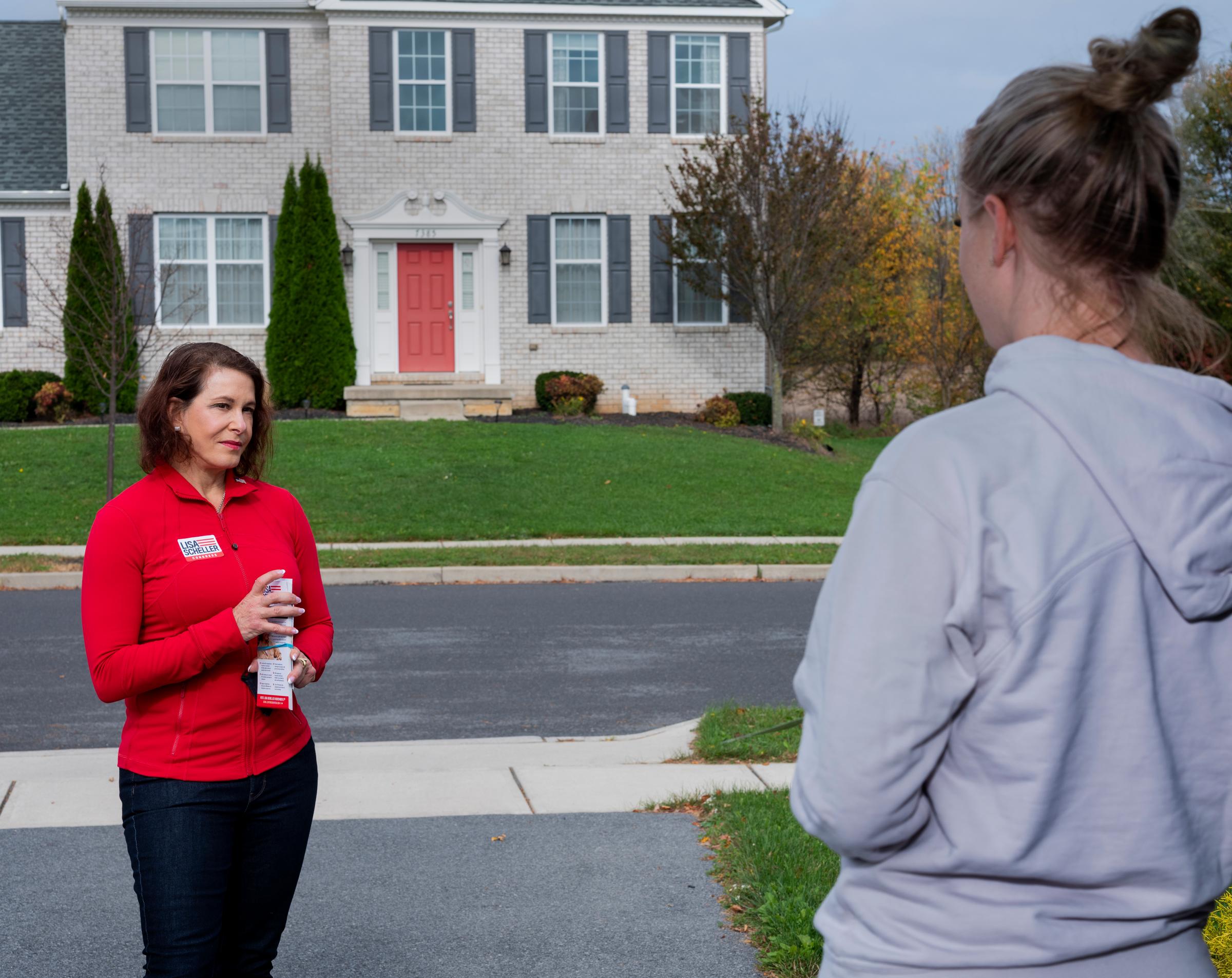
But by late summer, it was clear that Stefanik’s dream of a new class of female Republicans lawmakers in 2020 was unlikely to become reality. As the COVID-19 pandemic worsened and Trump’s popularity drooped, the only female Republican candidates who were shoe-ins to win their races were already in solidly-red districts. (Georgia’s Marjorie Taylor Greene, for example, who is slated to win her election has garnered headlines for her support of baseless Qanon conspiracy theories.) The rest of the expanded cohort of female Republican candidates are running in either Democratic or, like Scheller, tough swing districts—and are therefore much more vulnerable to the broader political winds. To make matters worse, they have been vastly outspent by their Democratic opponents. Scheller, despite self-funding, had approximately $478,000 in cash on hand as of October 14; Wild had $758,000.
“They’re getting screwed by the environment,” says Dave Wasserman, House editor of the non-partisan Cook Political report. “The top of the ticket is worse for Republicans than expected, even in districts Trump is carrying.”
In early October, the Cook Political report shifted Scheller’s race from “lean Democrat”—which meant she still had a solid statistical chance—to “likely Democrat,” which means her window has narrowed significantly. Republican candidate Karen Handel, who is running against Democrat Lucy McBath in Georgia’s 6th District, suffered the same fate, as did Nancy Mace, a top Republican female recruit, in her race against Rep. Joe Cunningham in South Carolina’s 1st District. Even incumbents have faced strong headwinds. Rep. Ann Wagner’s race in Missouri’s 2nd District slipped from “lean Republican” to “toss-up” in August. Four of the nine Republican female Senators are now fighting for their political lives in Iowa, Maine, Arizona and Georgia.
All is not lost for Republican women: some toss-up races, including those in Oklahoma’s 5th and Minnesota’s 7th Districts, remain competitive, and the total number of women in the Republican conference will likely increase this year, thanks largely to those female candidates running in solidly red districts. But overall, it’s also not great news for Republicans who believe that moderating the national conversation and expanding the tent is the only way to secure the long-term future of their party. If the majority of Republican women running in swing districts this year lose, the Republican conference will not only remain overwhelmingly white and male; it will also swing even farther to the right. Lawmakers will remain bereft of these women’s crucial voices, not only in legislating, where the nature of their districts renders compromise imperative, but in proving the Republican party is serious about broadening its demographic appeal—key to its appeal in the long run.
Barbara Comstock, the former Virginia Congresswoman who lost her race in 2018 to a Democratic woman, says that if Scheller and other Republican women running in swing districts lose, it’s a loss for the entire Republican Party. “We’re not going to be a majority party again,” she says, “until there are a lot more women candidates.”
‘A crop of particularly impressive women’
That a record-breaking number of women filed to run and won their primaries this cycle was not a fluke. It had a lot to do with Stefanik, the 36-year-old-congresswoman, who remembers watching the aftermath of the 2018 midterms with a mixture of despair and determination. That year, number of female Republican lawmakers shrank from 23 to 13, while Democrats brought in a record-breaking 35 new women. As the chairwoman of NRCC recruitment that cycle, Stefanik recalls feeling glad that more women were joining Congress, but disappointed that only one of them was a member of her party.
Recognizing that the biggest hurdle for would-be candidates is often the primary process, Stefanik—and a host of other Republicans working both inside and outside of Congress—began leveraging their respective political action committees to help up-and-coming women weather tough early contests. In January of 2019, Stefanik re-launched her political action committee, E-PAC, with the aim of recruiting more Republican women candidates for 2020, and fundraising on their behalf. Later that year, Winning for Women, a non-profit group formed in 2017 by longtime Republican donor Annie Dickerson, formed a super PAC to provide financial support for female candidates. Maggie’s List and VIEW PAC, a political action committee run by longtime Republican operative Julie Conway, continued to underwrite the effort, as they have done for years.
Stefanik also had no qualms about telling her party elders, nearly all of whom are male, that something needed to change. “‘Take a look around,'” she told her colleagues after the midterms. “’This is not reflective of the American public—and you need to do something about it.’”
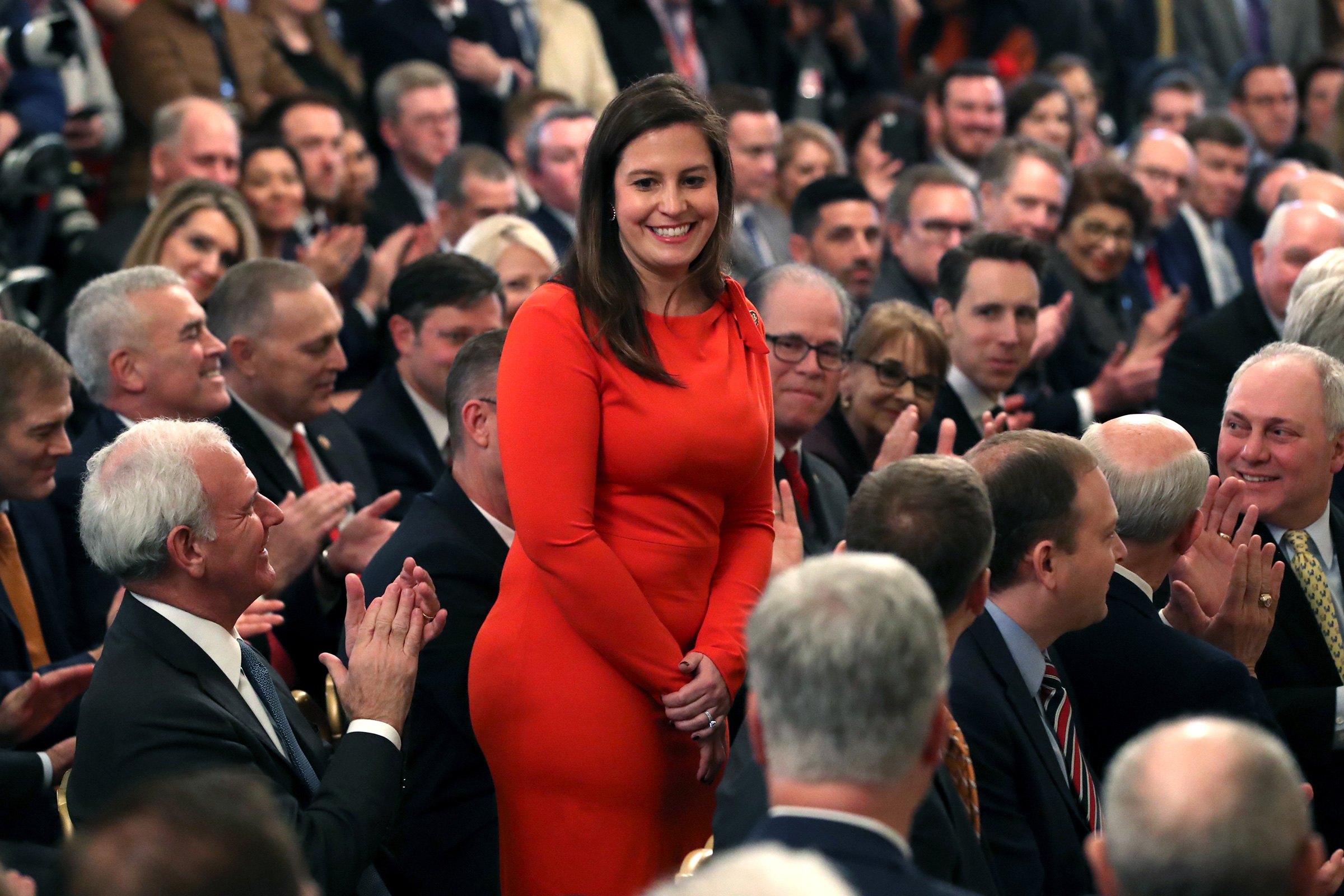
Kelly Dittmar, director of research at the Center for American Women and Politics, applauded Stefanik’s methods. “You can’t underestimate public shaming,” she says. “They are creating a greater sense that there is a problem, and that they are working on solving it.”
The response was enormous. In Oklahoma, Stephanie Bice, a rising star in the Oklahoma legislature, recalled how, like Stefanik, she was galvanized by the gender disparity between the two parties in 2018. “[The Democratic wave in 2018] was a wake up call for conservatives to say, ‘Wait a moment, not every woman is a Democrat,’” Bice said. “There are a lot of women that hold conservative values and we need to be represented.’”
By March of 2020, as the primary season began in earnest, the Republican party was on track to break its record of female candidates filing to run for office. Stefanik endorsed 32 candidates, including Scheller and Bice, and 29 went on to win their primaries. “What has really struck me is the depth and breadth [of these candidates,” says Rosalyn Cooperman, a political science professor at University of Mary Washington whose research focuses on female candidates. “This is a crop of particularly impressive women.”
VIEW PAC’s Conway, who has supported female Republican candidates for more than two decades, says the line-up was unprecedented. “We have arguably 25 [female candidates] where a really serious argument can be made that there is a reasonable path to victory,” she says. “That’s incredible. We’ve never had that before.”
Nearly all of these women faced challenging primaries, and that’s where Stefanik, whose national profile rose earlier this year as she emerged as a chief defender of Trump during his impeachment process, got involved personally. Stefanik’s endorsements were often accompanied by the maximum $5,000 from E-PAC, with an additional $5,000 for the general election. She and representatives from the other groups, including Conway, also acted as a crucial sounding board for inexperienced candidates, offering key advice on how to appeal to donors and navigate campaigning amidst COVID-19.
“They were there to help me with whatever I needed help with,” Scheller recalled. “They helped keep me motivated, they helped provide me with direction.”
An uphill battle
On the campaign trail in mid-August, Scheller stayed on message: the Democratic Party, she said, over and over again, has swung too far left. “I was very alarmed by what Bernie Sanders had to say,” she told roughly two dozen supporters who had gathered around platters of miniature cheesesteaks at an Allentown brewery, recalling the Vermont Senators’ speech at the Democratic National Convention. “The far radical ideas of the past few years have now become mainstream. What that means is we have the most leftist Democrat party in the history of our country.”
At Scheller’s second campaign stop immediately afterward, at a hunting club in Hellertown, she delivered virtually the same speech, this time to a parking lot full of supporters perched in socially-distanced folding chairs. Her opponent, she told the crowd, “wants to take your guns away.”
The most remarkable thing about Scheller’s roughly nine-minute stump speech was the absence of any mention of Trump himself—the man who has remade the Republican Party in his image, who dominates the political discourse, and who endorsed her during her primary in May. While some of Scheller’s supporters don Trump-Pence campaign gear—a sign, a t-shirt, a “Make America Great Again” hat—the candidate herself rarely invokes the Administration at all.

Tom Carroll, a Scheller supporter who wears a MAGA hat at the Allentown brewery and is the chairman of the local Tea Party, told me he wasn’t bothered by the absence of Trump shout-outs in Scheller’s speech. But before he could explain why, Scheller’s spokesperson, who had been following me around, tried to cut off the conversation. “We’re not going to talk about the President,” she says, nervously. “We’re just focusing on Lisa’s race.” Later, when I posed the same question to two middle-aged female voters, Roberta and Mickey, who described themselves as stalwart Trump supporters, Scheller’s spokesperson again tried to head off the discussion. “We’re running our own race,” she interjects. “We’re not running the President’s race.”
Scheller’s got good reason to avoid invoking Trump’s name. While it wouldn’t hurt her among the MAGA crowd, winning her swing district means reaching out to thousands of Republicans and Independents put off by the President’s antics. The latest Muhlenberg College/Morning call survey found 47 percent of Pennsylvania voters intend to cast a ballot for the Democratic congressional candidate in their district; just 41 percent backed the Republican candidate.
If Trump’s unpopularity is causing problems for down-ticket Republicans, the GOP’s funding deficit isn’t helping either. Putting aside Scheller, who was among the few with personal resources to self-fund her race, candidates in even the most competitive districts have failed to fundraise at nearly the same rate as their Democratic counterparts. Bice, who is running in Oklahoma’s 5th District, for example, raised just $3.1 million—more than 40 percent less than her Democratic rival’s $5.4 million. South Carolina’s Nancy Mace raised $4.9 million while her opponent raked in $6.4 million. In New York’s 11th District—another top pickup opportunity for the GOP—Republican Nicole Malliotakis raised less than half of what Democratic Rep. Max Rose raked in.
“It’s an incredibly difficult time to be running, especially against incumbents,” says Indiana Rep. Susan Brooks, who chairs recruitment for the National Republican Congressional Committee and is retiring this year.
The Republican women candidates’ support structure, which helped them through the primaries, couldn’t make up the difference in the general. Winning for Women raised slightly over $429,000 this cycle, according to financial disclosure records, while VIEW PAC and E-PAC both raised a little over $930,000. (Since April 2019, Winning for Women’s Super PAC has spent nearly $3 million on efforts supporting female candidates, according to a spokeswoman). The founders of these groups loath comparisons to the Democrats’ EMILY’s List, which supports pro-choice female candidates early on in the electoral process, but the differences are stark: EMILY’s List raised $72 million this cycle.
“If you’re looking at the political networks and particularly the campaign finance networks available to Democratic women, it’s not apples to oranges,” says Cooperman, the political science professor. “It’s like apples to filing cabinets.”
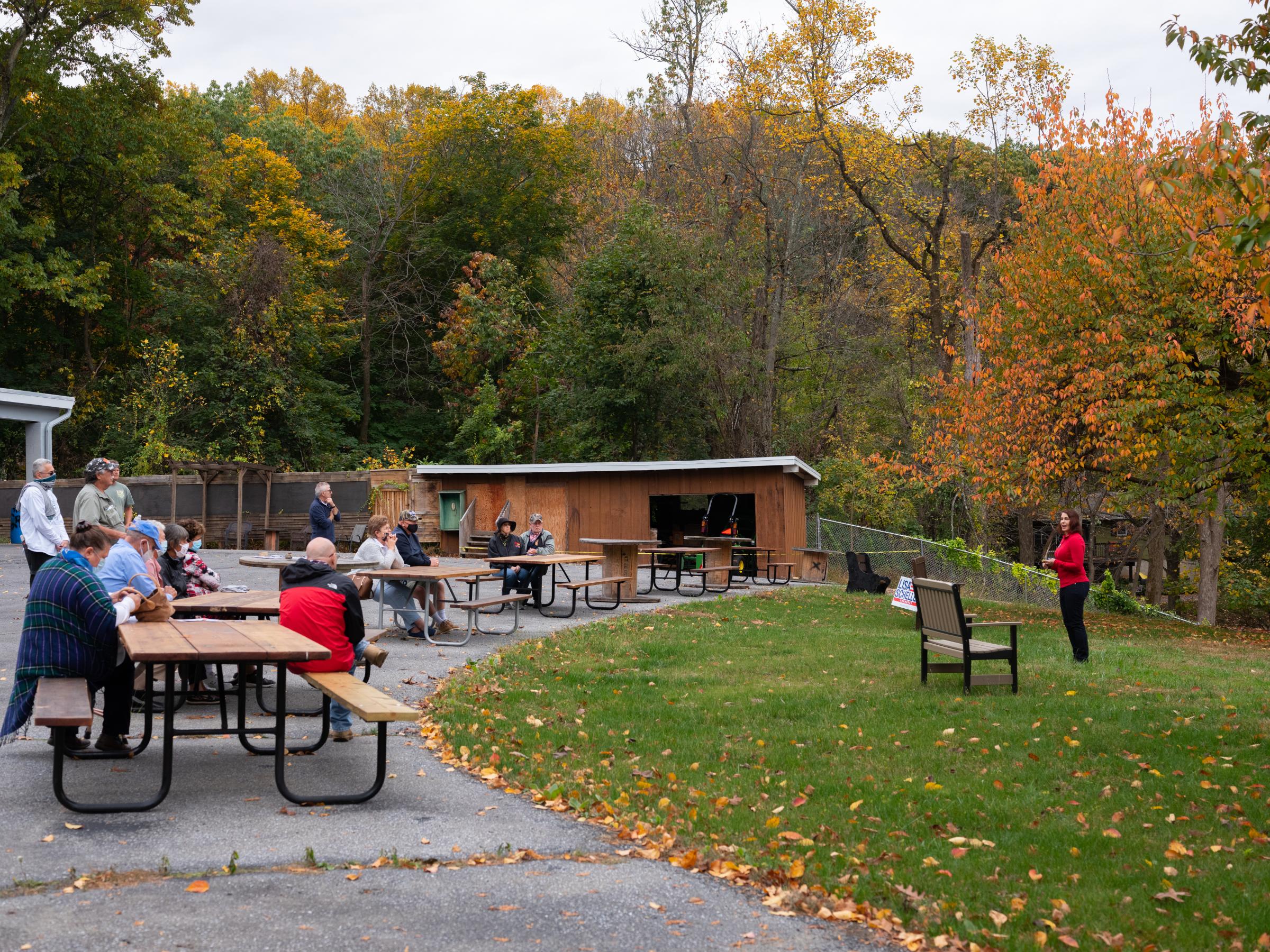
Built for the Long-Term
The female Republican candidates who manage to win their races in this tough election cycle will encounter a Congress that looks nothing like it did just a few years ago. Most moderate Republicans were wiped out in the 2018 midterms, and in the intervening two years, the burn-it-all-down ideology of the once-fringe Freedom Caucus—coupled with an intense devotion to the President—has remade the Republican conference. If a candidate like Scheller is able to pull out an unexpected victory, she would, by necessity, be something of a maverick voice in this milieu. Parroting Trump wouldn’t win her reelection; she’d have to reflect the more moderate convictions of her constituents.
That’s precisely why many party stalwarts, including Brooks, think it’s so important that the wave of female GOP candidates win in battleground districts, even if they end up representing a minority in the party. “In many of these districts,” says Brooks, “many of those candidates will be those kinds of members that will find certain issues to break from our party.”
Of course, a wave of losses among more moderate and mainstream Republicans will compound the problem, pushing the GOP even further right. Already, those schisms are beginning to emerge. Getting women through primaries in solidly conservative districts—the type of “safe” seat that propels lawmakers to leadership posts—has been a bigger struggle than getting them to win in swing districts. In a special election runoff in 2019 in North Carolina’s 3rd District, Winning for Women poured $900,000 into the race to support the female candidate, Joan Perry, only to see her lose to her male opponent in a landslide amidst support from the leaders of the Freedom Caucus.
“Some of the more conservative groups, [like the] Freedom Caucus, instinctively support the men and that’s been a problem,” says Comstock. “They are hurting their own cause and it’s unclear if they even want to be a majority anyway.”
Despite the headwinds, the female Republican candidates running this cycle remain determined, as do Stefanik, Conway, and their supporters behind the scenes. If 2020 ends up not being the year for a wave of female Republican freshman in the House, that day is coming, they say. “This ecosystem that we’ve built up,” says Comstock, “is built for long term.”
More Must-Reads from TIME
- Donald Trump Is TIME's 2024 Person of the Year
- TIME’s Top 10 Photos of 2024
- Why Gen Z Is Drinking Less
- The Best Movies About Cooking
- Why Is Anxiety Worse at Night?
- A Head-to-Toe Guide to Treating Dry Skin
- Why Street Cats Are Taking Over Urban Neighborhoods
- Column: Jimmy Carter’s Global Legacy Was Moral Clarity
Write to Alana Abramson at Alana.Abramson@time.com
